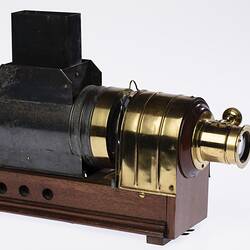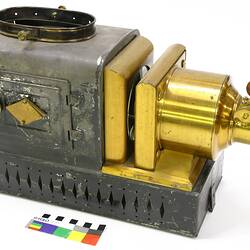Summary
Wooden "Eclipse" Slide Carrier manufactured by R.R. Beard, patented in 1886.
By the 1880s, lantern slides in the standard 3¼ x3¼ inch format were often produced without the older style wooden frames, using two sheets of square glass sealed around the edges with gummed paper binding tape. These glass slides had to be placed in a slide holder t to enable the projectionist to move them in and out of the projector. This style of slide carrier has a device that automatically centred the slide making the projectionist's work much easier.
With early slide changers, the projectionist had to lean over the lantern to remove used slides from the carrier. Later models returned the used slides to the projectionist' side, where they could easily be removed. The innovative 'Eclipse' design slide changer from R.R. Beard, of Fort Road, Bermondsey, England, was patented in 1886. Each slide could be pushed in front of the previous one before the latter was removed. This meant the slide was out of focus for a short while for the duration of the slide changeover.
The carrier also allowed a 'dissolving' effect to be produced with just one lantern.
This slide carrier is part of the Francis Collection of pre-cinematic apparatus and ephemera, acquired by the Australian and Victorian Governments in 1975. David Francis was the curator of the National Film and Sound Archive of the British Film Institute as well as being a co-founder of the Museum of the Moving Image in London, which was operational between 1988 and 1999.
Physical Description
Wooden slide changer with brass fittings. It has two long strips of wood forming the framework, with two shorter pieces added perpendicularly to form a square in the centre, where slide is to sit. The longer arm forming the top of the frame has a strip of rubber attached to the top, the bottom one has a "runner" to which slides are added and moved through the lantern projector. It has an ivory emblem attached.
More Information
-
Collection Names
-
Collecting Areas
-
Acquisition Information
Loan & Subsequent Donation from Australian Film Institute (AFI), Mr David Francis, by Nov 1990
-
Manufacturer
Beard, 90 Fort Road, Bermondsey, England, Great Britain, 1886
-
Collector
Mr David Francis, London, Middlesex, England, Great Britain, 1990
-
Inscriptions
Ivory emblem: '"ECLIPSE" R.R. BEARD PATENT' Stamped on runner: 'RRB'
-
Classification
-
Category
-
Discipline
-
Type of item
-
Overall Dimensions
33.7 cm (Length), 2.2 cm (Width), 11.8 cm (Height)
-
Maximum dimensions
25 mm (Length), 455 mm (Width), 118 mm (Height)
Measurement From Conservation. With slide carrier open
-
Maximum dimensions
25 mm (Length), 312 mm (Width), 118 mm (Height)
Measurement From Conservation. With slide carrier closed
-
References
[Link 1] - accessed 22 September 2008
-
Keywords





